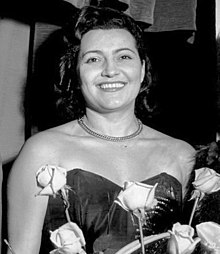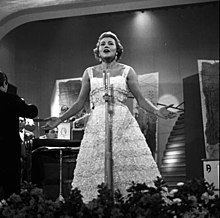Nilla Pizzi
This article includes a list of general references, but it lacks sufficient corresponding inline citations. (August 2023) |
Nilla Pizzi | |
|---|---|
 Pizzi as the winner of the Sanremo Music Festival 1952 | |
| Background information | |
| Birth name | Adionilla Pizzi[1] |
| Born | 16 April 1919 Sant'Agata Bolognese, Kingdom of Italy |
| Died | 12 March 2011 (aged 91)[2] Segrate, Italy |
| Genres | |
| Occupation(s) |
|
| Years active | 1940–2011 |
| Labels | |
Adionilla Pizzi (Italian: [adjoˈnilla ˈpittsi]; 16 April 1919 – 12 March 2011), known by her stage name Nilla Pizzi, was an Italian singer and actress.
Born in
Through her Sanremo performance career, she presented a total of thirty-one songs, as well as participating three more times as a guest and once as a presenter. Endowed with a charismatic, warm voice, she is considered the most successful Sanremo singer of all time.
Life and career
Early life and career beginnings
Adionilla Pizzi was the daughter of Angelo, a farmer also responsible for municipal road maintenance, and Maria, a tailor and seamstress. She had two younger sisters.[4]
She was first employed in tailoring, then at the military bakery in Casaralta (a borough of Bologna), and finally as a radio tester at Ducati, also in Bologna. Pizzi's career started out in the field of beauty reviews that, at the end of the 1930s, began to make their appearance. On 4 November 1938, at the age of 19, she participated in a show for the soldiers of the 59th Infantry Regiment of Bologna, as a feast for the Italian Armed Forces. In 1939 she participated in the Miss Italia contest.[citation needed]

In 1940, she performed in other shows organised for the Armed Forces, even being elected mascot of the 35th Infantry Regiment of Bologna. In 1942, she won a competition for new voices organized by
Her first album for
The period from 1948 to 1950 changed the trends and tastes of the public, due to the affirmation of the Latin American style imposed through Hollywood by
1950s

The 1950s saw her become the singer of many successful songs, as "Che bel fiulin", written for her by a certain Casasco. In 1951 she won the first Sanremo Music Festival with "Grazie dei fiori", also finishing second with "La luna si veste d'argento", sung in duet with Achille Togliani. "Grazie dei fiori" would go on to sell 36,000 copies, a massive success for the era. In the same year, the Italian version of the hit "Cherry Pink (and Apple Blossom White)", titled "Ciliegi rosa", was quite successful.

The following year she triumphed again at the Sanremo Festival conquering the entire podium (first, second and third place) respectively with "Vola colomba", "

She then successfully toured America, participating in radio and television broadcasts, recording records, and triumphing with the song "Croce di oro". In 1957, she won the Festival di Velletri with "Dicembre m'ha portato una canzone" paired with
1960s–1980s


In 1960, she returned to the Sanremo Festival and entered the song "Colpevole" in couple with Tonina Torrielli, ranking fourth, whilst her other entry "Perdoniamoci" was eliminated before the final. Starting from this period, the contrast of the ever-growing rock and roll and beat with Pizzi's traditional melodic song caused her to be set aside by record companies. Although she could no longer achieve the same success in Italy as in previous decades, the singer was still able to carve her own place in the music scene, both in Italy and internationally, under the auspices of her new label, the RCA Italiana, in the "revival-nostalgic" and "folkloristic" vein of music. She kept recording songs in different regional languages, and also participated very often as a guest in various television and radio broadcasts.
She opened a night club in
.Another successful tour of the United States took place in 1968, during which she performed alongside Frank Sinatra, Ella Fitzgerald, Perry Como and Rosemary Clooney. In 1970, she recorded the album Scritte per me, with twelve tracks by the greatest Italian authors and composers of the period such as Pino Calvi, Carlo Donida, Bruno Pallesi, Leo Chiosso, Carlo Alberto Rossi, the writer Leonida Repaci, as well as television presenters Pippo Baudo and Paolo Limiti. The album marked the transition to her new record label, Équipe. In 1972 her album Con tanta nostalgia won the Discographic Critics' Prize, a then very coveted award. In 1978 she participated as an actress in her last film: Melodrammore, the only film directed by Maurizio Costanzo. In 1981 Gianni Ravera called her to present the Sanremo Festival, alongside Claudio Cecchetto and Eleonora Vallone; Pizzi was the official madrina ("godmother") of the event on the thirtieth anniversary of the first edition. From 1986 to 1990 she formed, together with Carla Boni, Gino Latilla and Giorgio Consolini, the group Quelli di Sanremo ("The ones from Sanremo"), with which she performed in numerous events. In the television season from 1986 to 1987 she hosted the program L'allegro giovedì on the local Milanese television, which had the theme song "Un giorno all'italiana". From 1988 to 1992 she was the host of another local television variety broadcast by a Romagnol television station, entitled Romagna mia. In 1989 she participated in C'era una volta il Festival with "Grazie dei fiori", in which, although not entering the final, she was given a plaque-prize, awarded by a commission, where "Grazie dei fiori" was recognized as the most beautiful song of the first 40 years of the Sanremo Festival.
Personal life
On 24 September 1940, she married Guido Pizzi, a young construction worker to whom she was not related despite bearing the same surname. A few days after the wedding, her husband was recalled to the army and the couple separated.
In 1957, she secretly married in Acapulco the guitarist Carlo Porti, from whom she separated a few months later.
Death

On the morning of the 12 March 2011, Pizzi died, aged 91, at the Capitanio nursing home in Segrate, Milan, where she was admitted following an operation.[5] On the 16th of March 2011, her ashes were buried in the family chapel in the cemetery of Sant'Agata Bolognese, where the bodies of her parents rest.[6]
Sanremo participations
- 1951
- "Grazie dei fiori" – 1st
- "La luna si veste d'argento" (with Achille Togliani) – 2nd
- "Eco tra gli abeti" (with Achille Togliani) – 5th
- "La margherita" (with Duo Fasano) – 8th
- "È l'alba" – Failed to qualify for the final
- "Ho pianto una volta sola" – Failed to qualify for the final
- "Mia cara Napoli" – Failed to qualify for the final
- "Notte di Sanremo" – Failed to qualify for the final
- "Tutto è finito" – Failed to qualify for the final
- 1952
- "Vola colomba" – 1st
- "Papaveri e papere" – 2nd
- "Una donna prega" – 3rd
- "Nel regno dei sogni" – 10th
- "Buonanotte ai bimbi del mondo" (with Duo Fasano) – Failed to qualify for the final
- "Il valzer di Nonna Speranza" (with Duo Fasano) – Failed to qualify for the final
- "Ninna nanna dei sogni perduti" – Failed to qualify for the final
- 1953[a]
- "Campanaro" (paired with Teddy Reno) – 2nd
- "Sussurrando buonanotte" (paired with Teddy Reno) – 8th
- "Papà pacifico" (paired with Teddy Reno) – 10th
- "Canto della solitudine" (paired with Teddy Reno) – Failed to qualify for the final
- "L'altra" (paired with Flo Sandon's) – Failed to qualify for the final
- 1958[a]
- "L'edera" (paired with Tonina Torrielli) – 2nd
- "Amare un'altra" (paired with Gino Latilla) – 3rd
- "Giuro d'amarti così" (paired with Claudio Villa) – 5th
- "La canzone che piace a te" (with Aurelio Fierro; paired with Claudio Villa and Duo Fasano) – Failed to qualify for the final
- 1959[a]
- "Sempre con te" (paired with Fausto Cigliano) – 6th
- "Adorami" (paired with Tonina Torrielli) – Failed to qualify for the final
- "Il nostro refrain" (paired with Tonina Torrielli) – Failed to qualify for the final
- 1960[a]
- "Colpevole" (paired with Tonina Torrielli) – 4th
- "Perdoniamoci" (paired with Achille Togliani) – Failed to qualify for the final
- 1981: presenter with Claudio Cecchetto and Eleonora Vallone
- 1994: "Una vecchia canzone italiana" (as a member of Squadra Italia) – 19th
- 2000: special guest; awarded a prize by presenters Fabio Fazio and Luciano Pavarotti for the 50 years since her first victory
- 2003: special guest; awarded the City of Sanremo Prize
- 2010: special guest; awarded the City of Sanremo Prize for a second time
Notes
References
- ISBN 9788884403797.
- ^ "Nilla Pizzi". The Independent. 19 April 2011. Archived from the original on 21 June 2022. Retrieved 6 January 2020.
- ^ "Anno per anno la storia del Festival". La Repubblica (in Italian). Retrieved 14 August 2023.
- ^ Ruggieri, Paolo (1994). Canzoni italiane (in Italian). Vol. II. Fabbri Editori. pp. 229–240.
- ^ "Addio a Nilla Pizzi, regina di Sanremo" (in Italian). ANSA. 12 March 2011. Retrieved 15 August 2023.
- ^ "La grande Nilla Pizzi ora riposa a Sant'Agata". Il Resto del Carlino (in Italian). 24 March 2011. Retrieved 15 August 2023.
Sources
- Giannelli, Enzo (2019). Nilla ultima regina. La vita e la carriera di Nilla Pizzi (in Italian). Sacco.
- Pozzi, Italo; Musi, Giuliano (2017). Nilla Pizzi: storia di un sogno (in Italian). Minerva.
